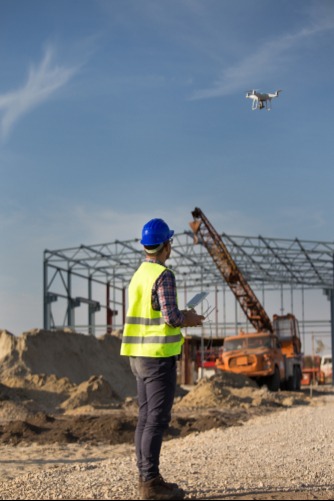The Rise of Drones in UK Construction

The UK construction industry is undergoing a significant transformation, driven by a need for greater efficiency, improved safety, and smarter project management. Among the most impactful innovations is the rise of drone technology.
A drone, also known as an Unmanned Aerial Vehicle (UAV) is a remotely operated or autonomous flying device equipped with cameras, sensors, or other payloads. Originally developed for military use, drones are now widely adopted across commercial sectors, offering a bird-eye view of environments that would otherwise be difficult, dangerous, or costly to access.
In construction sector, drones are being used to streamline surveys, monitor site progress, inspect structures, and capture data in real time. Their adoption is accelerating across the UK, with promising results in both large-scale infrastructure projects and smaller residential developments.
Key Use Cases in UK Construction
Here’s a glimpse into how drones are actively being used across construction sites in the UK, showcasing their versatility and efficiency:
- Aerial Site Surveys and Mapping:Traditional land surveys can take days to complete, often requiring significant manual effort. Drones equipped with advanced sensors like LiDAR and high-resolution cameras generate detailed 2D maps and 3D models. This speeds up site planning and reduces errors.
- Progress Monitoring: Weekly drone flights provide both visual and thermal data to create comprehensive progress timelines. This helps project managers identify delays early and keep all stakeholders informed with real-time insights.
- Site Safety Audits: Thermal imaging drones detect overheating equipment and potential electrical faults before they escalate, enhancing worker safety and reducing downtime caused by unexpected failures.
- Structural Inspections: Inspecting roofs, towers, and high-rise buildings traditionally involves scaffolding,lifts, or rope access, which can be costly and dangerous. Drones eliminate these risks by accessing difficult-to-reach areas quickly and safely,delivering high-resolution images for thorough inspections.
- Inventory and Asset Management: On large, sprawling construction sites, tracking materials and equipment is a challenge. Drones streamline inventory control by capturing aerial data that accurately monitors stockpiles and asset locations, improving resource allocation and reducing theft or loss.
Why are Drones taking off in UK Construction?
Several factors are accelerating drone adoption across UK construction sites:
- Speed and Efficiency:Traditional land surveys can take days or weeks. Drones, equipped with high-resolution cameras and sensors, can capture detailed topographical data in a matter of hours with greater accuracy.
- Improved Safety: Risky tasks like inspecting scaffolding, roofs, or hard-to-reach infrastructure can now be done from a safe distance, reducing the need for workers to be exposed to hazardous conditions.
- Labour and Skills Shortages: With the construction industry facing ongoing shortages of skilled labour, drones help fill critical operational gaps, especially in data gathering and inspection.
- Digital Transformation Goals: Drones are a natural fit in an industry increasingly adopting technologies like Building Information Modelling (BIM), IoT sensors, and AI-driven project management. The visual and spatial data captured by drones integrates seamlessly with these digital systems.
- Environmental and Cost Pressures: By identifying issues earlier and optimising resource use, drones reduce waste,lower carbon footprints, and help keep projects on budget and on schedule.
According to PwC, drones could deliver £8.6 billion in annual savings to the UK’s construction and manufacturing sectors by 2030, making them a strategic investment for firms looking to future-proof their operations.
Real-World Applications
The growing use of drones in UK construction is not just theoretical, it’s already reshaping how critical tasks are approached on-site. Here are two illustrative case studies that demonstrate the current and practical value of drone deployment in the sector.
- High-Rise Monitoring in London
In the dense urban environment of London, drones have proven invaluable in monitoring complex high-rise developments. Projects in Canary Wharf and Nine Elms have adopted drone technology to inspect curtain wall systems, check facade alignment, and conduct thermal imaging for insulation assessments.
Previously,such inspections required rope access teams or scaffolding, which involved high risk, disruption, and considerable time. Now, a drone can complete the same inspection in under an hour with minimal impact to the site or surrounding public spaces. Moreover, some developers are leveraging drone footage for public engagement, offering virtual 3D flythroughs to update investors and local communities, adding a layer of transparency and innovation to their communication strategies.
- Commercial Roof Inspection in Bristol
In Bristol, drones were deployed to inspect five commercial buildings covering over 100,000 square feet of roof space. Traditionally, such inspections would take several days, requiring multiple workers, scaffolding, and manual safety measures.
With drones, the entire roof area was surveyed in a single day using 4K video and high-resolution imagery. The technology helped identify structural concerns,leaks, and blockages with far greater speed and accuracy. The drone-based approach was approximately 75% faster than manual inspections and enabled immediate data analysis, accelerating the maintenance and repair planning process.
Tim Harris, from UK-based drone services provider RUAS, reflects on this shift:
“Using drones to inspect commercial roofs continues to transform the industry. In just a few short years, erecting a scaffold,climbing ladders and training staff already seems like something from the dark ages.”
These case studies reflect how drones are no longer experimental tools, they are established, effective instruments in modern construction workflows. From inspecting tall structures in dense urban zones to conducting large-scale assessments of commercial buildings, drones are being used today to reduce costs, improve safety, and deliver faster insights.
This progression mirrors trends seen in other high-risk, high-value industries like oil and gas, where drones have become indispensable for inspecting offshore platforms, monitoring pipelines, and detecting equipment faults in remote environments. Their success highlights the transformative impact of combining aerial intelligence with robust connectivity infrastructure.
Challenges Facing Drone Adoption in UK Construction
While drones offer transformative benefits, their integration into construction workflows is not without challenges. Understanding these hurdles is essential for successful adoption:
Weather and Environmental Limitations: Drones are sensitive to adverse weather conditions such as high winds, heavy rain, fog, or snow, which can delay flights or affect data quality. The UK’s often unpredictable weather can therefore constrain how and when drones are deployed on site.
Regulatory Compliance and Airspace Restrictions: The UK Civil Aviation Authority (CAA) strictly regulates drone operations to ensure safety. Operators must register their drones, pass competency tests, and often obtain permissions for flights, especially in urban or congested areas. Navigating these regulations can be complex and time-consuming, limiting spontaneous or flexible drone deployment.
Privacy and Security Concerns: Collecting aerial data on active construction sites raises privacy questions, particularly in urban environments near residential areas. Companies must navigate data protection laws and maintain transparency with communities to avoid legal issues and reputational damage.
Connectivity and Real-Time Data Transfer: For drones to deliver maximum value, especially when performing autonomous flights or transmitting data in real time, reliable network connectivity is essential. Many construction sites, especially in remote areas, lack the necessary infrastructure. Emerging connectivity solutions like private 5G networks offer promising capabilities to overcome these limitations. We will explore this critical role of connectivity in the next section.
The Role of Connectivity: Private 5G Networks
As drones become more integral to construction operations, the need for reliable,high-speed connectivity grows exponentially. Drones generate massive volumes of data, including high-definition images, thermal scans, and sensor readings.Transmitting this data in real time allows project managers and engineers to make instant decisions, improving responsiveness and reducing delays.Furthermore, advanced drone operations such as autonomous flights, swarm coordination, and AI-driven analytics require ultra-low latency and high reliability that conventional Wi-Fi or 4G networks often cannot guarantee.
Many construction sites face challenges like weak cellular signals, limited Wi-Fi coverage, and unstable internet connections due to their location, ongoing construction activity, or physical obstructions. These connectivity gaps hamper the ability to use drones to their full potential, particularly for real-time monitoring or complex flight operations.
How Private 5G Networks Transform Connectivity
Private5G networks provide a dedicated, secure, and high-performance wireless environment tailored to the specific needs of a construction site.
Key benefits include:
High Bandwidth and Speed: Private 5G supports large data transfers quickly,enabling real-time streaming of high-resolution drone footage without lag.
Low Latency: Near-instant communication allows drones to respond immediately to control commands and environmental changes, crucial for autonomous or semi-autonomous flights.
Enhanced Security: A private network limits access to authorised users and devices, protecting sensitive project data and reducing cyber security risks.
Scalability and Flexibility: Networks can be scaled to cover expansive or complex sites and adapted as projects evolve.
Reliable Coverage in Challenging Environments: Private 5G can be configured to maintain consistent connectivity despite physical barriers like cranes, concrete, or machinery.
What’s Next?
Drones have already secured their place on UK construction sites, but their evolution is just beginning. In the near future, we can expect to see a shift toward fully autonomous drone operations, with UAVs capable of planning and executing complex flight missions without human input. Driven by advancements in AI and real-time navigation systems, these drones will not only fly smarter but also analyse the data they capture.
Drones will also become a key part of smart cities. For example, a sensor on a bridge might detect something unusual, and immediately send a signal for a drone to fly over and investigate. Even more exciting, multiple drones may soon fly together in swarms. These “drone teams” can inspect large construction sites much faster, share information with each other, and keep working even if one drone has a problem. UK tech firms are already testing this for big infrastructure projects, like airport developments and housing expansions.
As construction becomes more connected through IoT and private 5G networks, drones will not just be tools, they’ll become intelligent teammates helping to build the smart cities of tomorrow.
"Drones could deliver £8.6 billion in annual savings to the UK’s construction and manufacturing sectors by 2030, making them a strategic investment for firms looking to future-proof their operations."







